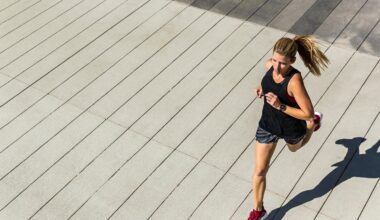Tracking Flexibility Progress: Journaling Tips for Seniors
Maintaining flexibility is essential for seniors to ensure their overall mobility. One effective method is keeping a journal dedicated to tracking flexibility progress. This journal can be a valuable tool in monitoring daily activities and flexibility practices. By writing down specific exercises, durations, and personal observations, seniors can witness their improvements over time. It creates a motivational source to encourage persistence and commitment. Moreover, jotting down how each exercise felt can help tailor future routines to individual needs. Providing accurate reflections on progress can help adapt and optimize flexibility programs accordingly. Seniors should choose a comfortable journaling medium, whether it be digital or paper-based, to ensure they can maintain the habit effortlessly. Setting aside a specific time daily to jot down experiences fosters consistency. Furthermore, noting any variations in mood, pain, or stiffness can highlight correlations with daily activities, further refining exercise strategies. Juxtaposing physical records with qualitative descriptions enables a comprehensive understanding of how their bodies respond to different forms of movement. This holistic approach will ultimately empower seniors, enhancing not only their flexibility but also their overall quality of life.
Incorporating specific goals in journaling can significantly elevate the effectiveness of tracking flexibility. Goals should be realistic, measurable, and relevant to individual abilities, fostering a sense of accomplishment. For instance, a specific target such as increasing the range of motion in the hips or gradually holding a stretch for an additional 30 seconds each week can be motivational. After setting these goals, seniors can create a chart in their journal to visualize their progress, making adjustments regular and manageable. Additionally, recording achievements, no matter how small, builds confidence and encourages a positive mindset towards flexibility training. Having the ability to look back and note previous milestones can be incredibly uplifting. Seniors may also find it beneficial to include reminders about the importance of warm-ups before stretches and cool-down activities afterward to prevent injury. As they write, they can reflect upon how flexibility influences their day-to-day life, enhancing physical activities such as walking, gardening, and playing with grandchildren. Engaging in this reflective assessment encourages mindfulness and deeper understanding of the body, creating a more enjoyable experience with the journey of maintaining mobility.
Understanding Flexibility Exercises
When journaling about flexibility, it’s vital to organize entries that showcase various exercises performed. Seniors can benefit from employing a diverse range of flexibility routines. These exercises can include static stretches, dynamic movements, and yoga poses. Each type plays a unique role in enhancing overall body flexibility. Static stretches, for instance, allow muscles to relax and elongate, while dynamic stretches improve range of motion through movement. Yoga combines both aspects, addressing both physical and mental flexibility. Documenting such exercises in the journal provides seniors with insights into what works best and what areas require additional attention. By monitoring the time spent on each routine, one can also recognize patterns that correlate with increased flexibility. Additionally, incorporating visual aids or descriptions can further enrich the journaling experience. Resources such as instructional videos or images of poses may serve as helpful tools. As seniors maintain consistency in their journaling, they become more acquainted with the nuances of how each exercise benefits their bodies, ultimately paving the way for lifelong habits that nurture flexibility and mobility.
Alongside tracking exercises, seniors should note how their bodies respond during and after flexibility work. This aspect of journaling is crucial for understanding personal limits and making informed adjustments in routines. Every individual reacts differently to physical activities, and journaling can unveil these unique responses. For nuanced insights, writers may use a scale to rate feelings of stiffness, pain, and ease of movement before and after various exercises. Such reflections help identify which activities yield the best results and promote recovery. Moreover, journal entries can encompass any adverse experiences or setbacks. Documenting these occurrences encourages seniors to analyze them critically, allowing for proactive adaptations in their flexibility routines. It’s also essential to recognize the emotional side of this journey; including daily mood reflections can reveal the psychological aspect of physical activity. Tracking how flexibility training relates to stress relief and overall happiness can be incredibly informative and uplifting. Furthermore, incorporating notes on hydration, sleep, and nutrition can tie back into flexibility, creating a comprehensive picture of health. This holistic view ultimately aids seniors in fostering a healthier lifestyle.
Social Motivation
Sharing journaling experiences with friends or family can foster accountability and enthusiasm. Seniors are encouraged to connect with their communities by participating in local flexibility classes or online forums. Engaging with others who share similar goals provides valuable social interaction, which is essential for emotional health. In doing so, they can exchange tips, celebrate progress, and even organize group exercises. Establishing social networks dedicated to flexibility activities encourages a fun and supportive environment. This social aspect can motivate seniors to stay committed to their routines, reducing feelings of isolation. Furthermore, seniors may wish to consider using their journals as discussion tools during social gatherings or meetings. Sharing insights on progress and challenges can inspire peers and create supportive dialogue. Additionally, inviting family members to participate in flexibility exercises together can strengthen bonds while promoting healthier habits. By turning journaling into a communal activity, seniors enhance their motivation to persevere through flexibility training. Furthermore, the interactions can reaffirm the importance of nurturing flexibility and mobility through shared efforts and experiences, ultimately creating a sense of camaraderie.
Regularly reviewing entries in a flexibility journal is a critical practice to grasp gradual improvements. Seniors should dedicate time weekly or monthly to reflect on their reported experiences. This exercise not only encourages self-reflection but also highlights progress that might not be noticeable on a day-to-day basis. By examining the patterns in entries, trends may emerge directly tied to the effectiveness of specific exercises, encouraging seniors to make informed choices moving forward. These reflections can reveal the cumulative effects of consistency, as well as milestones achieved over time. Journaling can also facilitate adjustments in routines by staggering planned rest days to avoid overexertion, thereby ensuring the longevity of one’s practice. Moreover, integrating feedback into modifications keeps the experience fresh and tailored to personal needs. It allows for an evolving journey where seniors continuously adapt as they progress or face challenges. These reviews ultimately empower them, reinforcing a sense of ownership over their flexibility and mobility journey. Ultimately, this longstanding habit leads to a greater sense of accomplishment and satisfaction as seniors achieve their physical and mental wellness goals.
Encouragement and Support
Encouragement plays a significant role in sustaining flexibility routines. As seniors navigate their journey, having supportive feedback can boost confidence and reinforce long-term commitment. Whether from family, friends, or healthcare professionals, uplifting words foster motivation. Additionally, seniors can include motivational quotes in their journals to inspire daily practice. Selecting pertinent phrases or affirmations resonates personally, serving as gentle reminders of the self-care journey. It is essential for seniors to surround themselves with positivity, especially during challenging times. Utilizing journaling to reflect on personal motivations, encouraging encounters, and the benefits felt from improved flexibility will anchor seniors where they need to be. Small victories should also be celebrated and recorded, as these affirmations can further inspire ongoing dedication. Furthermore, consistency fosters resilience, even when progress seems slow. Finding joy in each gentle stretch contributes to a positive mindset. Acknowledging the entire journey to improved flexibility rather than solely the endpoint enhances the experience and bolsters determination. Journaling thus becomes a personal sanctuary, embodying thoughts of resilience, strength, and hope throughout this essential part of senior life.
Flexibility plays a crucial role in enhancing seniors’ quality of life. It facilitates movement, independence, and overall well-being, making it vital to track progress. Through dedicated journaling, seniors can identify improvement areas, and develop tailored strategies to address them. This practice allows for personalized engagement in physical activities tailored to their unique needs. Ultimately, the combination of self-monitoring, social engagement, and consistent reflection leads to enhanced flexibility that supports holistic mobility, emphasizing the importance of sustainability in these efforts. Reflecting on their journey fosters positive reinforcement, encouraging seniors to acknowledge their achievements and stay motivated. Having concrete references from the journal serves as a powerful reminder of progress made and goals still ahead. Continuously nurturing flexibility through journaling empowers seniors with a sense of accomplishment. Every entry detailed in the journal becomes a testament to their dedication and growth in their body’s capability. This tailored experience not only enhances flexibility but transforms how seniors perceive and engage with their physical health endeavors across daily life. The road to greater mobility both physically and mentally is greatly supported through these journaling practices, ensuring that seniors can embrace their full potential in every aspect of life.


